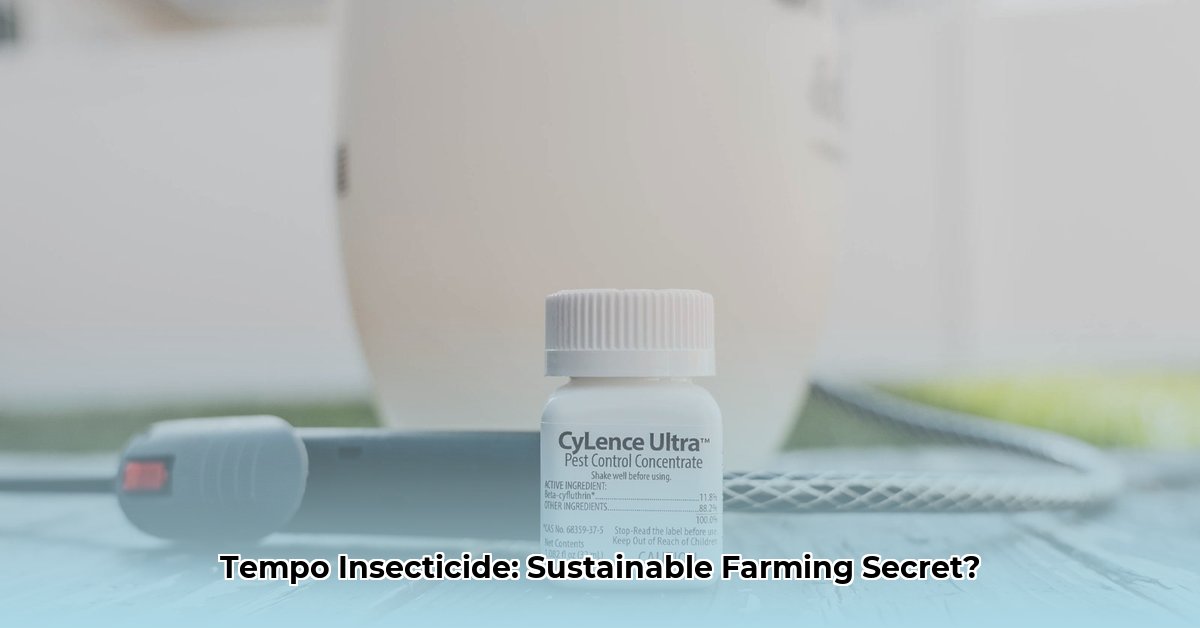
Finding effective pest control solutions is crucial for successful harvests. Tempo insecticide, readily available at Tractor Supply, offers a targeted approach. However, integrating it into a sustainable farming strategy requires careful consideration of its environmental impact. This guide provides actionable steps to use Tempo responsibly while minimizing harm to the environment. Check out Tractor Supply locations for availability near you.
Integrating Tempo Insecticide into Your IPM Strategy
Sustainable farming prioritizes smart pest management, not eradication. Integrated Pest Management (IPM) is the cornerstone of this approach. Tempo insecticide can be a valuable component within an IPM strategy but should not be the sole method.
Step 1: Accurate Pest Identification: Begin by correctly identifying the pests affecting your crops. This is vital for effective treatment.
Step 2: Consistent Monitoring: Regularly inspect crops for pest activity. Early detection allows for timely intervention and prevents widespread infestations.
Step 3: Prioritize Non-Chemical Methods: Before resorting to chemical pesticides, explore alternative solutions. Crop rotation disrupts pest life cycles, and introducing beneficial insects can naturally control pest populations.
Step 4: Targeted Tempo Application (When Necessary): If non-chemical methods prove insufficient and a significant pest threat exists, carefully consider Tempo insecticide. Strictly adhere to label instructions for dosage and application.
Step 5: Post-Application Evaluation: Assess the effectiveness of Tempo application. Note successes and areas for improvement to refine your strategy for future applications.
Tempo Insecticide from Tractor Supply: Benefits and Drawbacks
Tempo insecticide offers effective control of specific crop pests, but understanding both its advantages and limitations is crucial for responsible use.
| Advantages | Disadvantages |
|---|---|
| Effective control of target pests | Potential harm to beneficial insects if misused |
| Conveniently available at Tractor Supply | Requires precise application to minimize environmental impact |
| Targeted action minimizes non-target effects | Potential for pest resistance with repeated, un-integrated use |
Minimizing the Environmental Impact of Tempo Insecticide
Sustainable agriculture demands environmentally conscious practices. Here are key steps to reduce Tempo's environmental impact:
Precise Application: Use only the recommended amount; over-application is wasteful and environmentally harmful. Always follow label instructions.
Strategic Timing: Apply Tempo only when necessary, targeting pest life stages when they're most vulnerable. This minimizes pesticide use.
Protect Water Sources: Maintain a buffer zone around water bodies during application to prevent runoff and contamination.
Integrated Pest Management (IPM): Combine Tempo with other IPM techniques to limit reliance on chemical pesticides.
Responsible Disposal: Dispose of empty containers properly, following label instructions to prevent environmental contamination.
The Future of Sustainable Pest Management
While Tempo has a role in current pest management, sustainable agriculture necessitates exploring diverse and environmentally friendly alternatives. Research into biopesticides, pest-resistant crop development, and ecosystem management are crucial for long-term sustainability. "The future of sustainable agriculture depends on a holistic approach that integrates various strategies to minimize our reliance on chemical pesticides," says Dr. Emily Carter, Professor of Entomology at Cornell University. This continuous evolution is vital for balancing crop production with environmental stewardship. A balanced approach is key. Are you ready to evolve your farming practices?
How to Minimize Environmental Impact of Tempo SC Ultra Insecticide in Sustainable Farming
Key Takeaways:
- Tempo SC Ultra, while effective, presents environmental considerations in sustainable agriculture.
- Minimizing its impact hinges on precise application and integrated pest management (IPM).
- Exploring and implementing alternatives to chemical pesticides is vital for long-term sustainability.
- Transparency and responsible pesticide use are crucial for maintaining environmental responsibility.
Strategies for Reducing Environmental Impact
Minimizing the environmental impact of Tempo SC Ultra starts with responsible application.
Precision Application: Apply only to areas with pest infestations, avoiding unnecessary spraying to reduce overall pesticide use and runoff.
Integrated Pest Management (IPM): Combine Tempo with other IPM tactics such as biological controls, crop rotation, and resistant crop varieties to minimize pesticide dependence. This integrated approach is more effective than a single pesticide alone.
Strategic Timing: Apply Tempo only when strictly necessary, closely monitoring pest populations to determine the optimal time for intervention.
Buffer Zones: Create buffer zones around water sources to prevent pesticide drift and contamination.
Appropriate Equipment: Use calibrated application equipment to ensure precise delivery, minimizing pesticide waste.
Exploring Alternatives: Moving Beyond Chemical Pesticides
Research and implement biopesticides and other eco-friendly methods as alternatives to Tempo SC Ultra. These approaches offer effective pest control with a significantly reduced environmental footprint. "We need to shift towards a more proactive and preventative approach to pest management," states Dr. David Miller, Director of Sustainable Agriculture Research at the University of California, Davis.
Transparency and Accountability: Open Communication is Key
Open communication and transparency regarding pesticide use are vital. This allows for informed consumer choices and fosters responsible farming practices. Accountability for pesticide use strengthens sustainable agricultural initiatives.